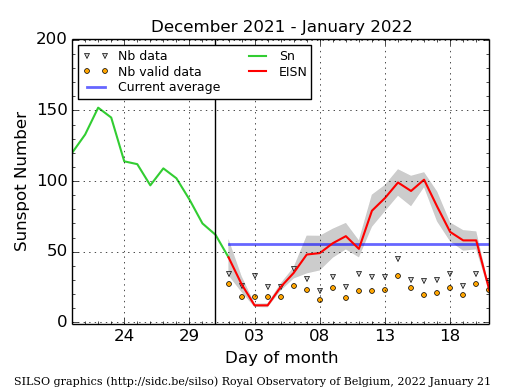Tad Cook, K7RA, Seattle, reports: A new sunspot group appeared on January 20, another on January 24, two more on January 25, and one more on January 26. But, overall solar activity declined from the previous week, January 13 – 19. Average daily sunspot number declined from 94.4 to 39.6, and average daily solar flux went from 112 to 97.6.
Predicted solar flux is 105 on January 27 – February 4; 108 on February 5 – 6; 110 on February 7 – 8; 108 on February 9 – 10; 106, 105, 103, 101, 100, and 95 February 11 – 16; 92 on February 17 – 18; 90 on February 19 – 21; 88, 87, 92, and 94 on February 22 – 25; 96 on February 26 – 28; 98 and 100 on March 1 – 2, and 105 on March 3 – 4.
Predicted planetary A index is 8, 5, 12, and 10 on January 27 – 30; 5 on January 31 – February 3; 15 and 10 on February 4 – 5; 5 on February 6 – 9; then 12, 15, and 12 on February 10 – 12; 5 on February 13 – 19; 6 on February 20 – 23; 5, 12, and 10 on February 24 – 26; 5 on February 27 – March 2, and 15 and 10 on March 3 – 4.
Look for reports on 6-meter openings in Friday’s bulletin.
Sunspot numbers for January 20 – 26 were 60, 23, 22, 22, 26, 53, and 71, with a mean of 39.6. The 10.7-centimeter flux was 99.3, 97.3, 95.2, 93.5, 95.2, 100.9, and 101.8, with a mean of 97.6. Estimated planetary A indices were 5, 8, 10, 8, 4, 13, and 10, with a mean of 8.3. Middle latitude A index was 5, 5, 7, 7, 3, 10, and 8, with a mean of 6.4.
A comprehensive K7RA Solar Update is posted Fridays on the ARRL website. For more information concerning radio propagation, visit the ARRL Technical Information Service, read “What the Numbers Mean…,” and check out the Propagation Page of Carl Luetzelschwab, K9LA
A propagation bulletin archive is available. For customizable propagation charts, visit the VOACAP Online for Ham Radio website.
Share your reports and observations.

